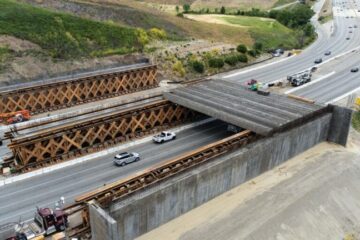NPS seeks greater control of surrounding hillsides
Rim of the Valley study now in fifth year
Source of this article: The Thousand Oaks Acorn, April 18, 2013
The mountains encircling the Conejo and Simi valleys may soon become part of the U.S. National Park Service.
The Conejo Mountain area, Simi Hills and Santa Susana Mountains make up the northwestern edge of what is known as the Rim of the Valley Corridor, an area that spans nearly 500,000 acres of mountains, forests and basins.
Besides Simi and Conejo, the Rim surrounds the San Fernando and La Crescenta valleys and includes the Santa Monica Mountains in the south and the Angeles National Forest in the east.
New management
In 2008, at the bequest of Congress, the National Park Service began studying the Rim of the Valley in an effort to identify whether the entire region should come under the control of the federal agency.
After releasing its preliminary findings late last year, NPS indicated that the corridor, including the portions in eastern Ventura County, does in fact meet the criteria for inclusion because it contains nationally significant resources.
Now park officials are trying to determine their next step.
Anne Dove, project manager for the Rim of the Valley Special Resource Study, said NPS came up with four alternatives.
One option is to take no action. The second involves creating a cooperative management partnership consisting of public and private landowners and interested organizations to oversee the entire Rim of the Valley. It would not create a new national park.
The third and fourth alternatives call for the expansion of the Santa Monica Mountains National Recreation Area (SMMNRA) to include parts of the corridor.
“We don’t have a preferred alternative yet,” Dove said. “There won’t be one until our final report comes out in 2014.”
Public outreach
![4p1[1]](http://www.venturacountytrails.org/WP/wp-content/uploads/2013/05/4p11-1024x644.jpg)
UNDER CONSIDERATION—A map shows the area that makes up the Rim of the Valley Corridor. The National Park Service is conducting a study to determine if the area would benefit by being included in the park system. The area outlined in brown is being considered for inclusion. Courtesy of National Park Service
Dove said the team received more than 5,000 comments on the study findings and alternatives, which are now being analyzed in preparation for a draft report scheduled to be released early next year.
Officials from the Santa Monica Mountains Conservancy, which manages the SMMNRA— already a part of the National Park system—expressed their support for the two alternatives in the study that would expand the unit’s boundaries.
Rorie Skei, deputy director of the conservancy, said expanding the SMMNRA boundaries would provide a “cohesive blueprint” for the park service to better assist in protecting local resources and habitat and preserving open space.
“Having the federal blueprint, as it were, may make it possible in the future for us to secure more federal funding,” Skei said, adding that it could allow NPS to assist local governments in acquiring properties from willing sellers, conducting scientific planning and enhancing outdoor recreation.
“Clearly, with the economy the way it is right now, funding for open space might not be the highest priority for the government,” she said. “But the big thing is it would formalize the partnerships that are in place now but also make it easier for the federal government to participate in partnerships with local governments, the conservancy, nonprofits and other entities in the larger, expanded area that we’re calling the Rim of the Valley.”
Concern over property rights
While most conservancy and local government officials have stated support for including Ventura County’s portion of the Rim in the National Park system, critics of the study have expressed concerns over what the move might do for private property rights.
In a letter to NPS, the Citizens Alliance for Property Rights of Ventura County favored “no action.”
“While (the other alternatives) might be well-intended, they would mark the beginning of an unnecessary expansion of federal bureaucracy with its accompanying costs in time and money and its inevitable threats to private property and local public control,” the letter states.
The Libertarian Party of Ventura County, the American Land Rights Association and Public Lands for the People also favored taking no action.
A public NPS workshop in Moorpark in November attracted 30 speakers, of whom only six said they favored expanding the SMMNRA boundary. The number of those favoring other alternatives was unavailable.
Moorpark City Councilmember Roseann Mikos, who sits on the Santa Monica Mountains Conservancy advisory committee, said most of the opposition came from property owners who were concerned about losing their rights if their land was included in the SMMNRA.
But during a Moorpark council meeting earlier this year, Mikos attempted to dispel that belief.
“It’s very clear that no one’s land is being taken,” she said. “They’re not being restricted. They really aren’t.”
Margie Steigerwald, an NPS planner who is part of the study team, cited the city of Malibu as an example.
“No one is losing their land,” Steigerwald said. “If you look at what NPS has done in the Santa Monica Mountains, for example, the entire city of Malibu is within the boundary. You don’t see too may people complaining about it in Malibu.
“They can buy and sell their land, and they can go to their local (government) if they want to subdivide.”
NPS has no regulatory authority over any land it does not own, the planner said.
And if National Park officials decide to acquire any new property, it would only look for “strategic partnerships” with willing sellers. NPS would also have no eminent domain—power to appropriate private property for public use—over any land in the boundary, Steigerwald said.
“(Expanding the boundary) wouldn’t change things for most people unless they want to sell their land,” she said. “Then we’d just be one more place they could go.”
According to Dove, about half of the current SMMNRA is publicly owned, while the other half is privately owned. About 15 percent of the total land belongs to NPS.
“When you see a boundary, it doesn’t mean the National Park Service is taking everything in the boundary,” Dove said. “We’re not going to purchase, nor do we want to purchase, all the property within that boundary. We’re only going to help facilitate opportunities.
“From the beginning of the study process, we tried to make it really clear that we won’t be including any alternative in the study that would include grand acquisitions (of land) by any means other than from willing sellers,” she added.
The NPS draft report for the Rim of the Valley Corridor Special Resource Study is scheduled for release in early 2014.
Preliminary findings and alternatives for the study are available online at http://www.nps.gov/pwro/rimofthevalley/.
The purpose of the special resource study is to determine whether any portion of the Rim of the Valley Corridor study area is eligible to be designated as a unit of the National Park system or added to an existing national park. The study will also explore other ways that private or governmental entities can protect resources and provide more outdoor recreation opportunities. For more information, go to http://www.nps.gov/pwro/rimofthevalley/



0 Comments